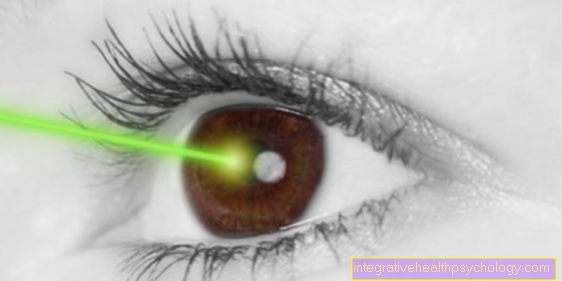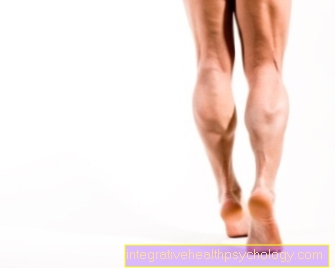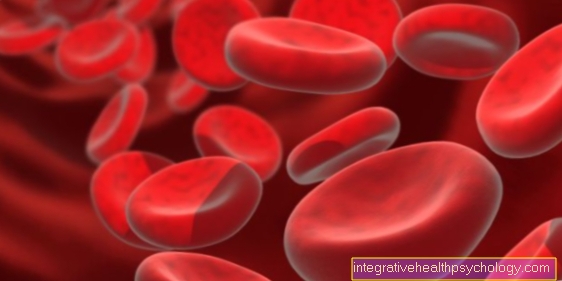Sweat glands
introduction
The so-called sweat glands are usually called eccrine sweat glands, i.e. those sweat glands that, with a few exceptions, are all over the body. Their task is to secrete sweat, which makes an important contribution to the regulation of the body's heat balance. There are also the so-called apocrine sweat glandswhich are only found in certain regions of the skin and whose function is the secretion of fragrances.

Occurrence
The eccrine sweat glands belong to the skin appendages, just like nails and hair. In humans, they occur all over the skin except for the lips and glans (the inner area of the penile foreskin). However, the density with which the skin is covered with sweat glands varies greatly from area to area. Most of the sweat glands are found on the soles of the feet and palms, namely around 600 per square centimeter. They are also found in large numbers on the forehead and the crook of the elbow. For example, places where there are only about 60 to 100 glands per square centimeter are the back and thighs. Eccrine sweat glands lie embedded in the subcutaneous tissue (Subcutis) and have an average diameter of 0.4 millimeters.
Structure of the sweat glands
These glands are unbranched and conduct the produced fluid via tubular ducts through the cutis to the surface of the skin, where the glands are then widened like a ball and the secretion takes place. The eccrine (like the apocrine) sweat glands are surrounded by a basement membrane. However, there is still a layer of smooth muscle cells between the gland and this membrane. These help to practically express the secretion from the glands and since they are controlled by the vegetative nervous system, they are not subject to our arbitrary control. The secretion of sweat takes place according to the exocrine mechanism, which describes the release of a substance to an internal or, in the case of the sweat glands, external surface. Among the exocrine glands, the sweat glands belong to the group of eccrine (merocrine) glands, which means that their secretions are secreted without any detectable loss of cellular components.
Function of the sweat glands
The function of the eccrine sweat glands is to produce what is commonly known as sweat. Sweat is a clear liquid that is slightly acidic (the pH is around 4.5) and salty. Sweat also contains other electrolytes than Table salt and other substances such as fatty acids, metabolic end products and antibacterial substances such as dermcidin.
Read more on this topic at: Sweat
The secreted sweat serves several purposes in humans. Its most important task is to regulate the body's temperature. Because it moisturizes the skin surface and evaporates from there, it has a cooling effect. In addition, through the fatty acids it contains, sweat supports the natural acid protection of our skin and makes it supple. In addition, the sweat also helps to fight off germs such as bacteria or fungi and thus participates in the immune defense. Last but not least, sweat also plays a role in detoxifying the body, as other urinary substances such as electrolytes and nitrogenous substances can also be excreted in it. So if the kidneys are restricted in their function, this disturbance can up to a certain point be compensated for by the sweat glands.
Difference between apocrine and eccrine sweat glands
The apocrine sweat glands differ from the in some important ways eccrine sweat glands. Their name is misleading as they do not secrete sweat but fragrance, but they are a slightly modified form of the sweat glands. In contrast to the eccrine sweat glands, the apocrine sweat glands do not exist from birth. They only develop during puberty.
Another difference is that these sweat glands are only found in certain areas of the skin, including genital organs, nipples and armpits. Although they are also located in the fatty tissue of the subcutaneous tissue, they are closely connected to the hair follicles: the secretion produced reaches the surface along the ducts on the hair shaft together with the secretion from the sebum glands. The exact function of these scent glands has not yet been conclusively clarified, but we already know that they are responsible for personal body odor and thus also for sexual behavior. In response to certain stimuli (especially excitement, fear or pain), they release their secretion, which among other things contains fragrances that represent sexual attractants.
Diseases of the sweat glands
Important diseases of the sweat glands primarily affect the quantity of secreted fluid: If there is no sweat production at all, this is called Anhidrosisbut if it is increased, there is one Hyperhidrosis in front. It can also lead to benign tumors (Adenomas) come in the area of the sweat glands.
Typical diseases of the sweat glands are:
- Sweat gland inflammation
- Overactive sweat glands
- Sweat gland abscess
Sweat gland inflammation
A sweat gland inflammation is also called acne inversa by dermatologists. It occurs mainly in the armpit but also in the groin or pubic area. Inflamed and painful lumps or abscesses in the affected areas are typical. The German name for sweat gland inflammation is misleading: the cause of the unpleasant skin disease is probably not an inflammation of the sweat glands, rather small sebum glands are mainly affected at the beginning. These are located within the hair roots. It is likely that these sebum glands are clogged, which allows bacteria to colonize. The immune system attacks these bacteria, causing inflammation and pus formation. However, the exact trigger factors are still relatively unclear. It is also suspected that the immune system or the affected sebum glands are malfunctioning. The sweat gland inflammation or acne inversa is a relatively common disease, it is assumed that up to 4% of the German population is affected. Smokers seem to be significantly more likely to fall ill than the rest of the population. Although sweat gland inflammation or acne inversa is a common condition, it is often misdiagnosed and is still relatively unknown. Acne inversa is usually treated with certain ointments, in severe cases with antibiotics or other drugs. If drug treatment is insufficient, the affected areas must be treated surgically.
Read more on this topic at: Sweat gland inflammation
Overactive sweat glands
Sweating is a very important function of the body. It allows precise regulation of body temperature. However, overproduction of sweat can also occur for various reasons. This is called in medicine Hyperhidrosis designated. A local form, in which, for example, only hands or feet are affected, is differentiated from a generalized form, in which all sweat glands in the body produce excessive sweat. In addition, there are special forms in which, for example, only half of the body or face can be affected. In addition, the overactive sweat glands can also be classified according to their cause. In the case of primary overactive sweat glands, no precise cause can be determined. There may be a malfunction of the autonomic nervous system, which controls the sweat glands. Trigger factors include heat, stress, but also certain foods. In secondary overactive sweat glands, another condition is the cause of excessive sweating. These include tumor diseases, infections such as tuberculosis or diabetes mellitus. Heavy night sweats are a common symptom, especially with tumor diseases or long-term infections.
Read more on this topic at: Excessive sweating
Sweat gland abscess
An abscess is an encapsulated collection of pus. It forms due to inflammation that attacks the tissue. A cavity filled with pus forms. This is encapsulated by the body in order to limit the spread of the inflammation. Sweat glands can also be affected by such a process. Sweat gland abscesses often appear in the armpit, groin or genital area. Often abscesses form in connection with a sweat gland infection, too Acne inversa called. Contrary to what the German name suggests, this disease initially affects the hair roots. From here, the inflammation spreads in the tissue, which can also affect the sweat glands. The triggers are presumably certain bacterial strains, but also lifestyle and possibly autoimmune processes. A sweat gland abscess can be very painful. Abscesses are typically recognized as red, swollen and warm capsules that are initially firm and filled with pus. Eventually the abscess will mature and possibly drain outward. An abscess should be treated by a doctor. A mature abscess in particular can be safely drained by a doctor. You can also use different ointments. If a skin disease such as acne inversa is the cause of a sweat gland abscess, there are a number of treatment options such as antibiotics or even an operation.
Read more on this topic at: Acne inversa
Sweat gland cancer
The sweat glands can also degenerate and form cancer. However, this rarely happens. Therefore, relatively little is known about tumors that originate from sweat glands. There are a number of different types of cancer. Sweat gland carcinoma, in particular, is malignant. It metastasizes relatively early. Often it is not the actual gland cells but rather the fine ducts of the sweat glands that seem to degenerate. Since the sweat glands are relatively superficial, sweat gland cancer is usually recognized as a palpable swelling in the skin. Surgical removal is usually the treatment of choice.
How can you remove sweat glands?
Excessive sweat production can be very stressful. For those affected, the unpleasant sweat odor that arises is usually particularly unpleasant, and in severe cases no deodorant can help.
Operative removal
In some clinics, surgical removal of the sweat glands is offered as a measure. This operation is usually performed in the armpit area. The procedure can be performed under general or local anesthesia. Technically, it is similar to so-called liposuction. The tissue under the skin is prepared by injecting saline solution. Then the required device is introduced through a small incision and the sweat glands including the surrounding tissue are suctioned off or otherwise removed. Surgical removal of sweat glands only makes sense if the cause of the excessive sweat production is not another physical disease, such as an overactive thyroid. In addition, an operation generally poses a risk for those affected. Therefore, all other ways of controlling sweat production should be considered beforehand. In addition, most health insurances do not pay for the procedure, or only in exceptional cases.
Read more on this topic at: Remove sweat glands - when does it make sense?
Can you obliterate sweat glands?
Sclerosing sweat glands differs from surgical removal. In the case of sweat gland obliteration, an attempt is made to damage the sweat glands using various methods so that they no longer produce sweat. In contrast to the removal of sweat glands, the glands remain in the body. There are a number of options to choose from. With laser lipolysis, the tissue is damaged by a laser in such a way that the sweat glands are inactivated. For this, however, a laser has to be inserted into the body, so the procedure is very similar to the surgical removal of sweat glands. When the sweat gland is sclerosed with Polidocanol, the active ingredient is injected into the areas to be sclerosed. This can also damage the tissue to such an extent that sweat glands are inactivated. New processes work with microwaves. In terms of their functionality, these are similar to sclerotherapy using a laser. The tissue is heated in a targeted manner and the sweat glands are obliterated. This procedure is still relatively new. Sweat glands should only be destroyed if a physical illness has been excluded as the cause of excessive sweat production. In addition, the procedures can be relatively expensive and are often not covered by health insurance companies.
Botox®
Botox® is a neurotoxin. Its effect is based on preventing synaptic signal transmission. As a result, nerve cells can no longer communicate with each other or with other cells. This can be used in the event of excessive sweat production, as the sweat glands are also controlled by fine nerve endings. If you inject a small amount of Botox® into an area with many sweat glands, these can no longer be controlled by the nervous system and sweat production comes to a standstill. This can be done in the armpit area but also on the hands or feet. The effect lasts up to a year, after which the nerve cells have regenerated. As with all treatments against excessive sweat production, it is questionable whether the health insurance companies will cover the costs. Physical illnesses as a cause of excessive sweat production should be ruled out beforehand.
Read more on this topic at:
- Botox®
- Side effects of Botox®


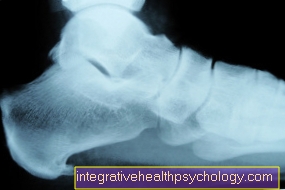

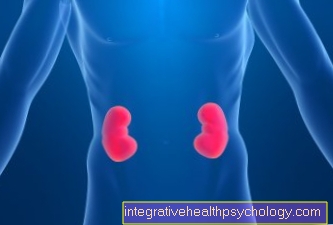


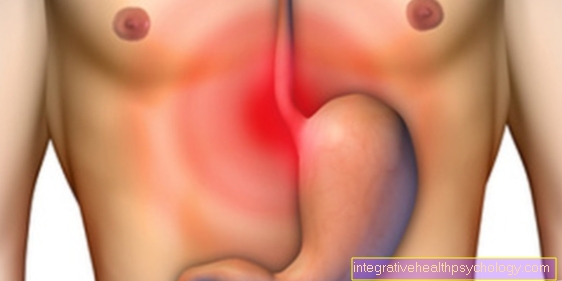

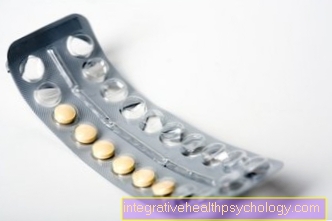




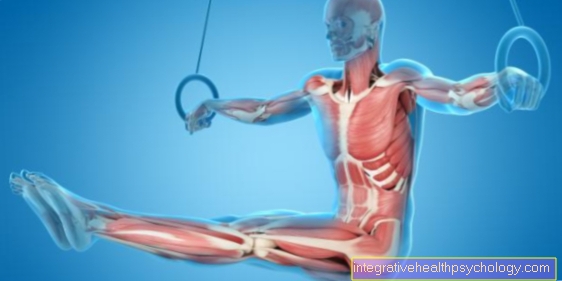



.jpg)





